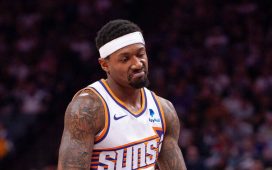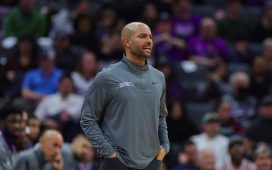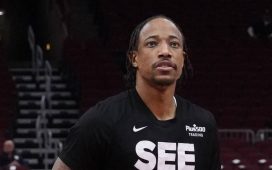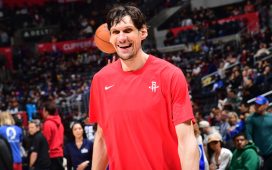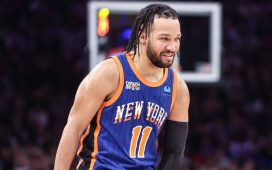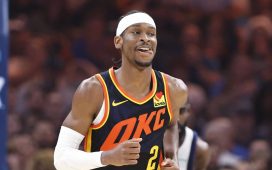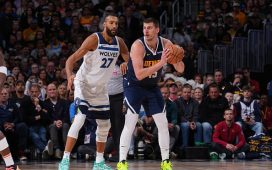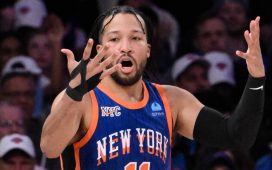The area on a tennis court halfway between the baseline and net is dubbed “no man’s land,” an area where players typically don’t want to find themselves — too far away to easily volley, too close to deploy groundstrokes on well-hit returns.
That may be a rough description of the state of sports TV consumption and where fans find themselves: stuck between two competing poles, the high-priced traditional cable TV universe and the fresher world of increasingly costly streaming. These options are pulling from the same sports, and in some cases, the same event and even the same match, leaving fans either missing out or forking over more money than ever. To get the best sports coverage, it’s not clear whether to rush forward to streaming, stay back with old-fashioned cable and broadcast television, or some combination of the two.
Companies like ESPN (ESPN+), NBC (Peacock), and CBS (Paramount+) are balancing the need to satisfy consumers paying hefty cable bills with the move to streaming, an area in which these conglomerates have spent — and lost — billions of dollars. While the belief abounds that one day everyone will stream, that day is not today, and sports fans are stuck between old- and new-world paradigms.
“There is as much art as science to it,” said sports media consultant Lee Berke, on how sports broadcasters decide what goes behind a streaming paywall and what resides on traditional linear TV. “You don’t want to get too far ahead of the curve, and you don’t want to be too far behind.”
It may be an art deciding how to carve up sports and tournaments between online and TV, but the results are often arguably unsightly.
Take the ongoing Australian Open as an example, which has elicited social media howls from tennis fans, and players, for the way ESPN distributes the matches between linear ESPN2 and its streaming app. In the past, the night matches in Australia ending at breakfast time on the East Coast stayed on regular TV, and tennis viewers eagerly awaited turning on the end of matches. This year, ESPN’s coverage ends at 2 a.m. ET, with the remainder pushed to ESPN+, until the final days of the tournament. Thrilling matches, from Andy Murray’s comeback from two sets down to beat Australian Thanasi Kokkinakis to American Coco Gauff beating 2021 U.S. Open champion Emma Raducanu were streamed. Even ESPN3.com, which had streamed matches available to cable subscribers, had only ESPN+ matches.
“It’s incredible how many social media users are voicing their frustration about this on Twitter and Reddit the last eight days,” said Levi Young, 39, a tennis fan in Los Angeles. “With four Grand Slams a year, so many tennis fans in this country have to wait until July when Wimbledon begins to watch a full tournament.” Wimbledon requires more linear coverage in its ESPN deal.
Even the tennis community noticed. Ajla Tomljanovic, a quarterfinalist at last year’s Wimbledon and U.S. Open, and former ATP Tour pro Jesse Levine were among those tweeting frustrations during Murray’s comeback.
How is there no coverage of this match in the States 🤯🤬
— Ajla Tomljanovic (@Ajlatom) January 19, 2023
How is tennis not on tv in the states right now? Yes espn + I get it, but one of the biggest tournaments in the world and can’t even watch!!
— Jesse Levine (@jesselevine7) January 20, 2023
ESPN said it is airing more hours of the tournament on linear this year than last year, but there is no getting around it: Fans of tennis, and other sports, should expect more content to migrate online as the cable bundle shrinks and streamers seek to finally make money.
“Monetizing the streaming platforms is increasingly important because we’re running out of gas on the price increases on the established pay TV bundle,” said Patrick Crakes, a former Fox Sports executive and currently a media consultant. They need “to distribute across all platforms … they’re twisting dials and looking for the right calibration, looking for the right frequency.”
That frequency of putting sports behind a streaming paywall is sure to pick up and capture more than just late-night tennis matches. Already, soccer has major events like the UEFA Champions League (Paramount+) largely all on streaming, not to mention Major League Soccer’s pending Apple TV+ debut. Even the NFL streamed a game exclusively (other than in the two teams’ local markets) on ESPN+ with Week 8’s Broncos–Jaguars game in London.
How do the networks decide what they will stream versus what they’ll put on traditional TV?
“A lot of that is laid out many years in advance,” answered Rick Cordella, president of programming for NBC Sports and Peacock Sports.
When a game isn’t contractually obligated to one platform, then the network has to make a decision on where it delivers it — broadcast, cable, or streaming. And sometimes, all three at once.
The obvious big events will remain on the national linear broadcast network, Cordella said, but there is a discussion about games and matches that are not quite the top-tier events.
At NBC, which has the U.S. rights to the Premier League, the programmers consider factors such as how long it’s been since a team has appeared on a particular platform, Cordella said. And now, the Premier League matches are getting about the same viewership on Peacock as they did on cable, he added.
Timing also is a big factor — is there a broadcast window available? That’s more limited on linear television than digital delivery, which can not only stream an event but also provide perks such as full coverage of press conferences, highlights, stats and other elements that a traditional broadcast cannot.
By now, streaming programming isn’t a terribly complicated process, Cordella said, and it has eased up as the networks gain experience and the service grows with content and new media rights.
“Most of them come to us and they’re fairly obvious,” he said of where to place content. “It’s a bit of an easier decision.”
NBC also has Notre Dame football, which streamed one game the past two seasons exclusively on Peacock, and will have Big Ten football games it’ll put behind the streaming paywall as part of its new media rights deal with the conference. Decisions on which games to stream will be made during the season, not ahead of time when the full schedule is released, to take advantage of changing storylines much like the NFL does with flexing late-season games into national broadcast windows.
There also remains the tension between putting important matches on linear TV versus putting them on streaming to entice new subscribers and grow revenue. The rights bills still have to be paid, so it’s poor business to fill streaming services with low-interest content that doesn’t grow the subscriber base — even if it creates irritation among consumers who must pay for another service atop their cable bill.
“There will be big games on Peacock,” Cordella said. “Peacock is a big part of that (revenue) equation. We’re not ashamed of putting games on Peacock. But it has to be the right mix. There is some art and science to it.”
He added that NBC surveys its Peacock subscribers and results show that the most satisfied customers are its Premier League and WWE fans.
“People are relatively happy with Peacock,” he said.
At CBS, the decision on what’s exclusively streamed on Paramount+ versus put on linear TV, or both, is generally made when the media rights are negotiated.
“The strategy is always very intentional at the outset,” said Jeffrey Gerttula, executive vice president of digital at CBS Sports, News and Stations.
The network has the same pressures to find the balance between getting the biggest audiences for its expensive sports programming while growing Paramount+ subscription revenue, but it tries to do that before a season begins.
“We have a clear idea around the business model that’s going to drive the business that supports the rights fees,” Gerttula said.
“Our approach is unique. We have all the biggest stuff on Paramount+ and also on CBS,” Gerttula said.
Unlike NBC’s Big Ten football deal, CBS isn’t waiting until a season begins to decide what will be streamed versus on broadcast and cable — it’ll use all three delivery modes.
“For us, we knew that deal was going to be a broadcast focused-deal,” said Dan Weinberg, CBS Sports’ executive vice president of programming.
CBS is able to switch content to streaming or broadcast if a rights partner wants to later make a change.
“We think that flexibility is important,” Weinberg said. “We’re always open to having those conversations.”
Disney-owned ESPN declined to comment in general about its strategy but vigorously defended its approach to the Australian Open.
While major championships such as the Super Bowl, World Series, NBA Finals, Stanley Cup finals, The Masters, etc., will remain on linear TV (while simul-streamed) for the foreseeable future, fans can expect to see the next tier down of important programming such as playoff games, move to streaming-only. But when and who will take that bold and risky first step?
“For a finals, it’s going to be a long time to come,” Berke said, but he expects early-round playoff games to begin migrating to streaming-exclusive in the next three to five years.
The mass distribution model for entertainment (including sports) has evolved several times, starting with the move from radio to television in the 1940s and ’50s, then to cable in the 1980s and ’90s. Then, the rise of the internet, smartphones, and social media added additional complex aspects to distribution.
Now millions of households rely on broadband internet to deliver sports and entertainment rather than coaxial cable.
“The inflection point was this: When the cable TV audience became as large as the broadcast TV audience, you had to satisfy both,” Berke said. “We’re starting to reach that with broadband distribution. More and more content will be found exclusive or semi-exclusive on streaming because that’s where your audience is. Content where the audience is.”
The biggest leagues have been making major moves toward streaming. The NFL recently struck a deal for its Sunday Ticket package to go from DirecTV satellite to Google’s YouTube TV and Thursday Night Football migrated this season to Amazon Prime Video. Major League Baseball has been putting some Friday night games on Apple TV. And the NBA’s next set of national media rights deals is expected to include a streaming component.
But for now, the audience is still primarily on cable, though only in about 65 million homes, down from 100 million a decade ago. Those who have stayed are paying steep sums every month and so don’t take kindly to paying extra for what they had previously had with their cable package.
So while it might seem easy to just pay $10 for the month and get ESPN+ to watch all of the Australian Open, some fans of the event complained on social media about already paying handsomely through their cable bill for ESPN.
I refuse to pay for @espn plus on principle at this point. I’m sure if they get enough people subscribing to watch AO, next it’ll be Wimbledon and the USOpen
— Here for the party (@TennisLurker) January 19, 2023
Unfortunately for @tennislurker and others similarly situated, they will find themselves in the media equivalent of no man’s land without access to a lot of what they want to watch.
(Photo of Andy Murray after his win over Thanasi Kokkinakis at the Australian Open: Clive Brunskill / Getty Images)

